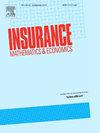Equilibrium investment strategies for a defined contribution pension plan with random risk aversion
IF 2.2
2区 经济学
Q2 ECONOMICS
引用次数: 0
Abstract
This paper investigates equilibrium investment strategies for a defined contribution (DC) pension plan member who faces random risk preferences. Downside protection for the pension plan and stochastic inflation are considered. The pension plan member is allowed to invest in cash, in an inflation-index bond, and in a stock in the financial market. Besides financial market risks, the wealth of the pension account is influenced by the stochastic contribution of the pension plan member. We adopt the framework proposed in Desmettre and Steffensen (2023) to tackle the time inconsistency issues arising from the incorporation of random risk aversion. The problem is first transformed into a self-financing investment problem and the semi-closed form of the equilibrium investment strategies is derived under the power utility function up to the solution of an ordinary differential equation (ODE) system. Our numerical analysis reveals that using expected risk aversion rather than random risk aversion results in a substantial welfare loss for the pension plan member.
随机风险规避下固定缴款养老金计划的均衡投资策略
本文研究了面对随机风险偏好的固定缴款养老金计划成员的均衡投资策略。考虑了养老金计划的下行保护和随机通货膨胀。养老金计划的成员可以在金融市场上投资现金、通货膨胀指数债券和股票。除了金融市场风险外,养老金账户的财富还受到养老金计划成员随机缴费的影响。我们采用Desmettre和Steffensen(2023)提出的框架来解决由于纳入随机风险厌恶而产生的时间不一致问题。首先将该问题转化为一个自筹资金投资问题,推导出在幂效用函数下的均衡投资策略的半封闭形式,直至常微分方程(ODE)系统的解。我们的数值分析表明,使用预期风险厌恶而不是随机风险厌恶会导致养老金计划成员的实质性福利损失。
本文章由计算机程序翻译,如有差异,请以英文原文为准。
求助全文
约1分钟内获得全文
求助全文
来源期刊

Insurance Mathematics & Economics
管理科学-数学跨学科应用
CiteScore
3.40
自引率
15.80%
发文量
90
审稿时长
17.3 weeks
期刊介绍:
Insurance: Mathematics and Economics publishes leading research spanning all fields of actuarial science research. It appears six times per year and is the largest journal in actuarial science research around the world.
Insurance: Mathematics and Economics is an international academic journal that aims to strengthen the communication between individuals and groups who develop and apply research results in actuarial science. The journal feels a particular obligation to facilitate closer cooperation between those who conduct research in insurance mathematics and quantitative insurance economics, and practicing actuaries who are interested in the implementation of the results. To this purpose, Insurance: Mathematics and Economics publishes high-quality articles of broad international interest, concerned with either the theory of insurance mathematics and quantitative insurance economics or the inventive application of it, including empirical or experimental results. Articles that combine several of these aspects are particularly considered.
 求助内容:
求助内容: 应助结果提醒方式:
应助结果提醒方式:


